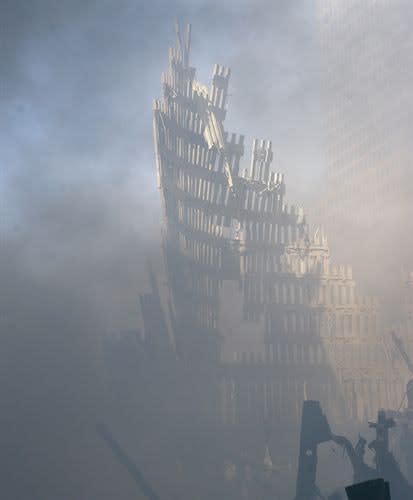The cloud started to drop down after the crash and most of the debris was already on the ground as we started to make sure everyone in the area was OK. We started documenting the area with photos and updating the other Metro Fire units and receivers with what we were seeing. We were moving when we could, hampered by clouds of smoke in our way. When we turned the corner, we found the initial response staging area. All the vehicles in the area were crushed, burning, windows were blown out and everything was covered in debris. It was like a war zone photo.
We had no time to take pictures. We immediately began washing off firefighters who couldn't breathe because they were covered in debris and ash. After we rehabbed those in the area, we started putting out numerous debris fires with fire extinguishers. Then we heard it again. The same terrifying cracking sounds we had heard with tower 1. Tower 2 was coming down and we couldn't believe it. Then we heard that snap, as the entire top, antenna and all, imploded on itself and came crashing down. We had no place to go this time.
We dove through a door into a nearby bagel store. Unfortunately, it had glass windows so we then had to dive over the counters to get into the rear of the building. When we realized the windows were still intact, Dave, from Unit 18, immediately opened the door and yelled out to the emergency workers trapped in the smoke and ash. Coming in one after the next, they were each covered in ash and unable to breathe. We turned the bagel store into an emergency rehab/treatment area and started hosing off everyone coming in.
Once the area we were in was stabilized, we returned to the "war zone" to re-evaluate. We updated Metro as soon as we could and got right back to putting our even more fires and dodging exploding car fires. We photographed what we could, when we could. Engine 33, which was the primary engine company hooked into a hydrant in our area, had no water pressure.
We immediately rushed to the Hudson River, two blocks down, to await the arrival of Marine 6, which we heard was on the way. Once they arrived, we stretched a 3" hose from the river all the way to the scene, recruiting bystanders to help. After they started a good water supply, we resumed our mission of photographing and providing detailed information over the radio system.












